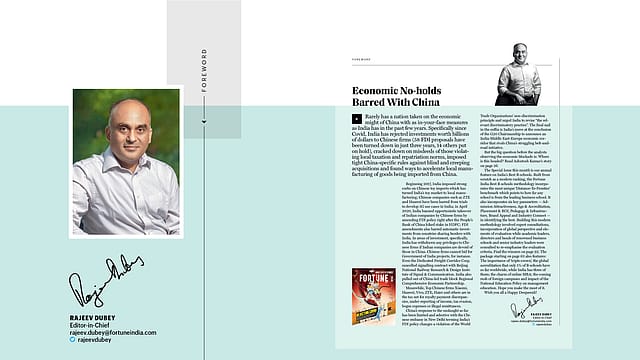Economic No-holds Barred With China

RARELY HAS A NATION taken on the economic might of China with as in-your-face measures as India has in the past few years. Specifically since Covid, India has rejected investments worth billions of dollars to Chinese firms (58 FDI proposals have been turned down in just three years, 14 others put on hold), cracked down on misdeeds of those violating local taxation and repatriation norms, imposed tight China-specific rules against blind and creeping acquisitions and found ways to accelerate local manufacturing of goods being imported from China.
Beginning 2017, India imposed strong curbs on Chinese toy imports which has turned India's toy market to local manufacturing; Chinese companies such as ZTE and Huawei have been barred from trials to develop 5G use cases in India; in April 2020, India banned opportunistic takeover of Indian companies by Chinese firms by amending FDI policy right after the People's Bank of China hiked stake in HDFC; FDI amendments also barred automatic investments from countries sharing borders with India. In areas of investment, specifically, India has withdrawn any privileges to Chinese firms if Indian companies are devoid of those in China. Chinese firms cannot bid for Government of India projects, for instance. Even the Dedicated Freight Corridor Corp. cancelled signalling contract with Beijing National Railway Research & Design Institute of Signal & Communication. India also pulled out of China-led trade block Regional Comprehensive Economic Partnership.
Meanwhile, top Chinese firms Xiaomi, Huawei, Vivo, ZTE, Haier and others are in the tax net for royalty payment discrepancies, under-reporting of income, tax evasion, bogus expenses or illegal remittances.
China's response to the onslaught so far has been limited and selective with the Chinese embassy in New Delhi terming India's FDI policy changes a violation of the World Trade Organizations' non-discrimination principle and urged India to revise "the relevant discriminatory practice". The final nail in the coffin is India's move at the conclusion of the G20 Chairmanship to announce an India-Middle East-Europe economic corridor that rivals China's struggling belt-and-road initiative.
But the big question before the analysts observing the economic blockade is: Where is this headed? Read Ashutosh Kumar's story.
The Special Issue this month is our annual feature on India's Best B-schools. Built from scratch as a modern ranking, the Fortune India Best B-schools methodology incorporates the most unique 'Distance-To-Frontier' benchmark which points to how far any school is from the leading business school. It also incorporates six key parameters — Admission Attractiveness, Age & Accreditation, Placement & ROI, Pedagogy & Infrastructure, Brand Appeal and Industry Connect — in identifying the best. Building this modern methodology involved expert consultations, incorporation of global perspective and elements of evaluation while academic leaders, directors and heads of renowned business schools and senior industry leaders were consulted to re-emphasise the evaluation criteria. The package also features: The importance of 'triple-crown', the global accreditation that only 1% of B-schools have so far worldwide, while India has three of them; the charm of online MBA; the coming rush of foreign campuses and impact of the National Education Policy on management education. Hope you make the most of it.
Wish you all a Happy Deepawali!